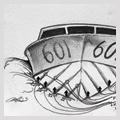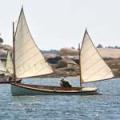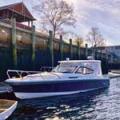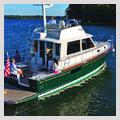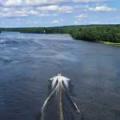The Small-Boat Water Tribe
A special breed of sailors and their quirky innovations
 Shellback pundits on Atsena Otie Key assess the clew connections on a highly evolved capsule cruiser. Photo by Jan Adkins
Shellback pundits on Atsena Otie Key assess the clew connections on a highly evolved capsule cruiser. Photo by Jan Adkins
Florida’s Gulf Coast is thin water. Enormous flats reach out from beaches, intricate passages weevil through mangroves and cypress islands. Gin-clear springs feed tannin-black rivers that meet the Gulf hesitantly, through a wilderness of swamp channels and islets. It’s a unique ecosystem and a challenge to navigation. Only boats that will float on a few inches of water can explore it. Since 1984, shoal-draft boat adventurers have gathered on the beach at Atsena Otie Key, just off Cedar Key, for the Cedar Key small-boat meet. It’s a friendly mix of vagabond sailors: the West Coast Trailer Sailing Squadron, trailer sailors from as far as Michigan and Los Angeles, the Traditional Small Craft Association, and the regional kick-ass hardies who call themselves the Water Tribe, of which more anon.
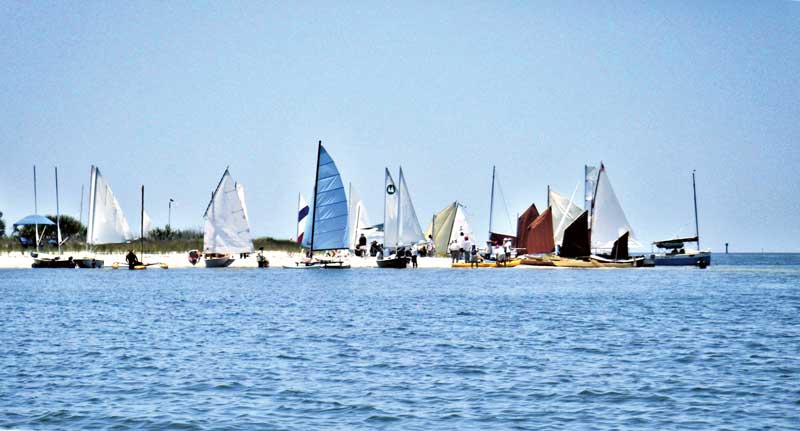 Small boat meet morning on Atsena Otie Key, before the beach crowds up. Photo by Dave Lucas
Small boat meet morning on Atsena Otie Key, before the beach crowds up. Photo by Dave Lucas
The fleet includes factory-made boats, each customized to reflect its skipper’s style. For example, Steve Wood is known as a Bay Hen guru to other Bay Henners. He’s experimented with scores of ways to upgrade the sturdy little sharpie’s performance and comfort. His current cat-rigged gaff-sail Bay Hen trails a curious wooden tail. Approaching the beach, he demonstrates this Chinese yuloh, a 10' sculling sweep with its inboard handle line-tethered to a hard point on the cockpit floor. Compared to a pair of oars it seems extravagant, but the single sweep manages its own feathering angles and pushes the Hen with economical strokes and a fetching wiggle of the transom.
Steve is an airplane pilot and an experienced airship pilot, skippering the Goodyear and Fuji blimps and testing experimental lighter-than-air ships. His depth of experience isn’t unusual. Listening to the enormous fund of sailing savvy on this beach is like being in a Napa Valley wine cellar, surrounded by extraordinary vintages. These are seriously experienced sailors and theorists sharing a priceless encyclopedia of been-there-done-that.
Ron Hoddinott started the West Coast Trailer Sailing Squadron here in 1998. Trailering a small but serious camp cruiser was a new concept then, but has blossomed, and he has been this meet’s toastmaster since the beginning. “All these people are veteran cruisers, racers. A lot of them have loads of bluewater sailing behind them, but these small boats are just so much fun.”
Many of these boats are one-offs, designed by naval architects and built by professional boatwrights with skills from the last century. A healthy number are home-built boats from plans or even computer-cut plywood kits, the sweat of the skipper in every detail. Some are wholesome little fishing craft and sailing dinghies, handsome kayaks and canoes. A growing number are pocket cruising boats.
There are radical departures, like Meade Gougeon’s own Elderly Care, a purpose-built thin-water racer. Meade was a kind of demigod on this beach. He and his brothers, Jan and Joel, changed the way modern boats are built with their West System epoxy/wood construction.
The central hull of Gougeon’s trimaran is as slim as a single rowing shell. Its primary purpose is the Everglades Challenge, a 300-plus-mile endurance race that starts in Tampa, runs south through the coastal archipelago, then east through the Everglades (a shallow sea of grass and a labyrinth of confusing channels) and ends at Key Largo. The trip can take eight days—a long time to spend on a racing shell about as wide as your hips. In 2017, Gougeon, at 78, took first place in his class with a time of 6 days, 10 hours. Meade Gougeon died seven months later on August 27, 2017.
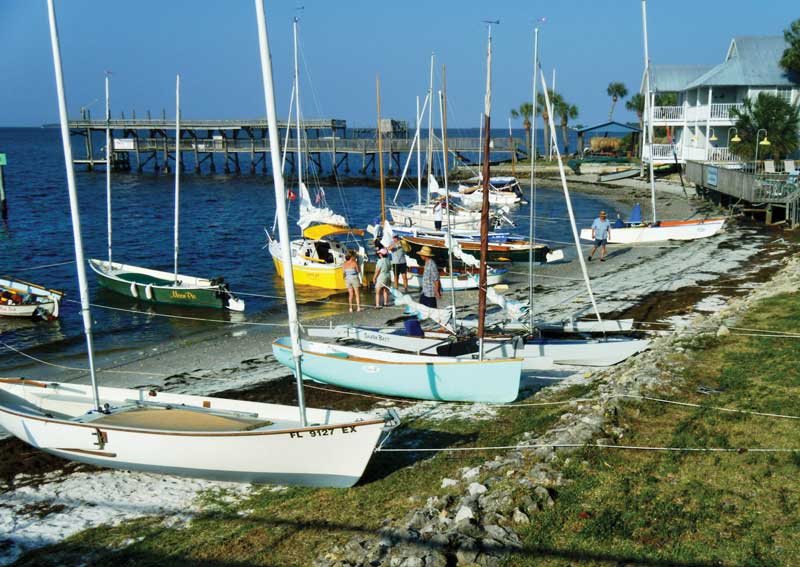 Thin-water skimmers hauled up, or Med-anchored, on Cedar Key beach before crossing to Atsena Otie. Photo by Dave Lucas
Thin-water skimmers hauled up, or Med-anchored, on Cedar Key beach before crossing to Atsena Otie. Photo by Dave Lucas
Hugh Horton, a local, is a designer and builder of small boats. He and his partner Karen arrive in a splendidly traditional little Bufflehead sailing canoe that he designed. His “traditional” canoe is a canard: its construction is less 1880s era, more Area 51, with a Kevlar lining under wood and West System epoxy fiberglass. What passes for a vintage rig is actually an experimental 21st century gunter rig with aerodynamic advantages that I don’t understand, and neither does DARPA.
Horton beaches his stealth “old timer” beside real vintage boats and a range of hybrids. Canvas on wood canoes converted to beach-sailing cruisers. Wood, canvas, and plastic kayaks expanded to trimarans with outriggers and amas. Dismasted fiberglass sloops reconfigured as thin-water motorcruisers.
The Tupperware Navy is well-represented—mass produced trimarans like Jim Brown’s WindRider that rip back and forth at breakneck speeds, coming close to turtling or even pitchpoling now and then, righting at the last moment with started sheets, then rooster-tailing away in another direction while their skippers hoot over the wind. One of the WindRider skippers races into the beach at close to 15 knots, grating high up on the sand and running an ama right over an orange plastic kayak. This Gulf wind intoxicates trimaran pilots to a dangerous degree.
What we discover on this beach is an outdoor laboratory of hydrodynamic experimentation. But add beauty; never doubt that the sailor’s eye is vulnerable to lovely curves. These experimental boats are cherished, admired, discussed. Each boat on the beach is a seminar between a constantly shifting audience and the boat’s owner, his or her advocates, their skeptics. At intervals, pairs or single sailors wade out to draw boats off the sand—for science’s sake, of course—to catch the fitful wind and race away. A fish-hook shaped shoal at the southwest corner of Atsena Otie shelters the water off the beach. There’s no surf; this is polite water. Most of these thin-water vessels are as lean as stilettos and cancel leeway with centerboards, daggerboards, or side-mounted leeboards. They gather speed in the calm water and shoot into the chop beyond the fishhook, sometimes grazing their boards in a momentary stumble as they pass over the shoal sand.
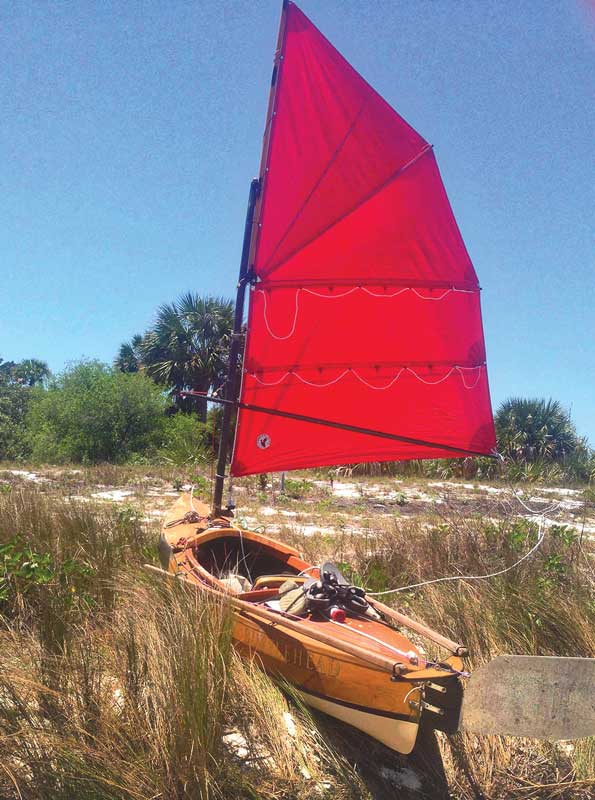 Hugh Horton’s Bufflehead sailing canoe, a 50/50 boat: “Sail when you can, paddle when you must.” Photo by Jan Adkins
The meet is unregimented. Any boat that can be beached is welcome. Several conventional sailing canoes made the windy half-mile crossing from the mainland with their doll-sized leeboards and low sails. A fiberglass copy of a Beetle Cat, native to Dartmouth, Massachusetts, demonstrates traditional shallow-draft competence and catboat simplicity. Dories and Whitehalls are represented in variously practical forms. Some boats are achingly beautiful, like a black-hulled Melon Seed catboat. A Caledonia yawl resting in the sand is an open sailing boat of traditional beauty, boatwright joinery, and impeccable varnish complexion—like a vintage photograph of an impossibly beautiful Ziegfield girl.
Hugh Horton’s Bufflehead sailing canoe, a 50/50 boat: “Sail when you can, paddle when you must.” Photo by Jan Adkins
The meet is unregimented. Any boat that can be beached is welcome. Several conventional sailing canoes made the windy half-mile crossing from the mainland with their doll-sized leeboards and low sails. A fiberglass copy of a Beetle Cat, native to Dartmouth, Massachusetts, demonstrates traditional shallow-draft competence and catboat simplicity. Dories and Whitehalls are represented in variously practical forms. Some boats are achingly beautiful, like a black-hulled Melon Seed catboat. A Caledonia yawl resting in the sand is an open sailing boat of traditional beauty, boatwright joinery, and impeccable varnish complexion—like a vintage photograph of an impossibly beautiful Ziegfield girl.
Some boats arrive with unusual small-boat propulsion units. Pedal-drive fishing kayaks are big business, now, and one team of developers is on the spot, troubleshooting a new gear unit that has begun to eat up its own cogs. It’s hard not to admire Hobie’s graceful swish-swish fin drive, because the company took a refreshingly sideways look at propulsion. There is a deep discussion over some weirdly bent carbon-fiber double kayak paddles, undoubtedly efficient, and undoubtedly Tiffany priced.
One of the reasons we’re at the meet is to review a new boat by a young designer, JF Bedard. The “JF” is for Jean-Francois, a Montreal native with the hint of French Canadian in his patois. He’s created a remarkable microcruiser, called the RoG, for “River of Grass,” a common description of the Everglades. It’s a pixie boat, 15' overall and weighing only 450 pounds, run up of Bruynzeel marine plywood only 6 millimeters thick (about a quarter of an inch). What makes a boat like this possible, and what makes it so astonishingly solid, is the Gougeon brothers’ epoxy-wood technology.
Another factor makes RoG possible and encourages the expansion of this beach fleet: CAD, computer aided design. Every boat is a vessel of compromises, this for that—broad hull for carrying capacity, narrow lines for speed, and a hundred other virtues/vices. When Bedard changed any line of his hull’s three-dimensional curves, his computer instantly confided the change in buoyancy, wetted surface, center of resistance. This mathematical miracle didn’t happen in a massive mainframe at MIT but in his laptop. Just as reduced basic cost and lower maintenance burden of small craft puts boating adventure within the reach of middle-class sailors, the RoG demonstrates the democratization of design. CAD allowed him to orchestrate weight and strength and hull shape, space below for two good bunks, a congenial cockpit, and a handy cat-ketch rig with easy full-batten sails. Bedard’s design wasn’t the product of generations of trial and error, or wave-tank testing. His primary solutions responded to his sense of a boat’s possibilities, mandated by his sailing philosophy—in this case he reached for trailerable, small, light, shallow-draft beach cruising, easy to launch and retrieve, easy to handle in light or heavy wind, big enough for an afternoon sailing party or for a thin-water cruising exploration for two.
The RoG was a contender in the 2017 Everglades Challenge, finishing with a second-in-class time of 6 days, 6 hours and 34 minutes.
The Challenge is mounted by the Water Tribe, a curious group of (supposedly) normal people gone a’Viking. These ardent outdoorspeople avoid round-the-buoys racing and they sidestep bragging rights by disguising themselves with Tribe names—like Penguinman, Lugnut, Gentrification, Clacker, TwoBeers. The Water Tribe favors “adventure racing,” endurance sailing over courses that challenge boat and skipper, requiring navigation skills, practical seamanship, and physical stamina. Competition is keen in the Tribe but the emphasis is on experience and harmony with their unique Gulf waters.
The Water Tribe is something new in sailing and sport in general. Their challenges are part of their particular seascape, low profile and small radius, small-boat shoestring ventures on local water. In 2000, the Water Tribe’s “chief” (anonymously) described their program, “to encourage the development of boats, equipment, skills, and human athletic performance for safe and efficient coastal cruising using minimal impact human- and wind-powered watercraft based on kayaks, canoes, and small sailboats.”
The Tribe seems to value exploration more than competition, experience over victories. It’s not a spectator sport but personal, or tribal, accomplishment.
There’s a solid precedent for small boat adventure travel. In the 1860s John MacGregor sailed Europe, Africa, and America in his celebrated Rob Roy canoe, traveling thousands of miles alone, beach camping and reporting his exploits to a broad audience. In the 1870s, Robert Louis Stevenson, author of Kidnapped and Treasure Island, traveled through Europe in a double-ended canoe, writing An Inland Voyage. In 1911, Frederic Fenger sailed his 17' rudderless canoe, Yakaboo, from Grenada up the Windward Isles, beach camping and dozing during passages, writing Alone In the Caribbean.
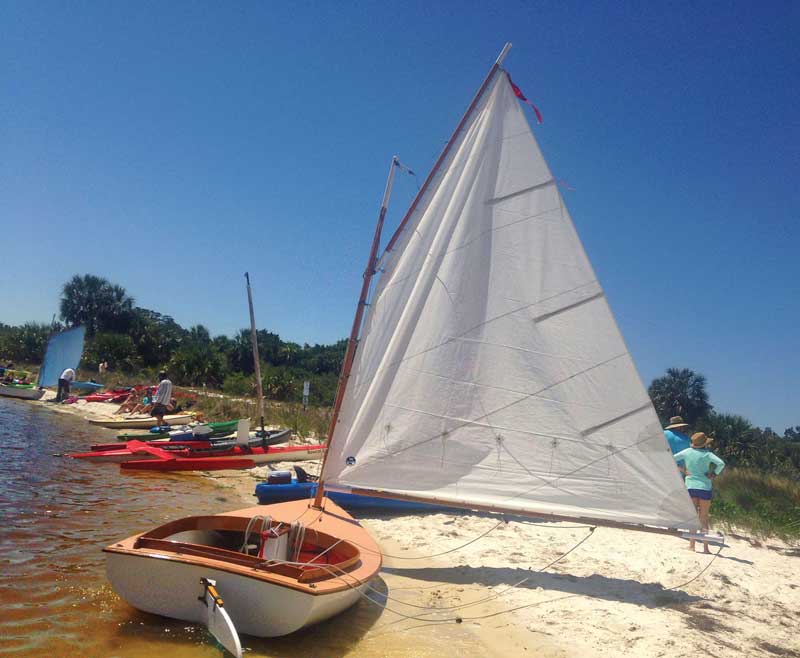 An off-duty fiberglass Beetle Cat, a Yankee far from home but comfortable on the Gulf’s thin waters. Photo by Jan Adkins
An off-duty fiberglass Beetle Cat, a Yankee far from home but comfortable on the Gulf’s thin waters. Photo by Jan Adkins
The current gurus of beach camping are here on the beach with us: Ida Little and Michael Walsh, who have beach cruised full-time for 20 years. Their book Beachcruising and Coastal Camping is a kind of Tribe bible. Is beach cruising an artifact of another age, or did it simply lapse into obscurity for a time? Canoeists and kayakers, especially in Canada and Maine, have been steadily voyageuring on thin, inland water. The only difference between those paddle canoeists and beach cruising is a big horizon and a bit of sail.
What re-started this obsession with little craft? Certainly the recession of the 1980s convinced plenty of sailors that a full-sized “yacht” was an enormous expense for occasional use. The boating market changed from modest locally built sailing boats to name-brand fiberglass yachts. Customarily owner-maintained family cruising sailboats kept on town moorings shifted to boatyard contract maintenance and marina slips. The price of annual ownership increased enormously.
And the pace of life quickened. Leisure time was pruned by two-job families. Helicopter parenting and soccer-mom social influences made leisure days more precious. Long sailing cruises from a home base became less possible.
A small boat is a smaller initial investment with a fraction of the maintenance and no slip charges. You launch and retrieve your boat, yourself. Since you’ll be in and out of the water in a short time, toxic (and expensive) bottom paint isn’t an issue. Trailering a boat puts you in new water quickly—many Florida trailer sailors and kayakers make pilgrimage to the Michigan fjords, the Bras d’Or lakes of Nova Scotia, or the Sea of Cortez. A road trip takes you and your boat to completely fresh cruising ground.
It’s difficult to compare cruising in a traditional sailboat versus exploring from a small camp-cruiser. The fixed bunks, head and galley of a big boat can be comforting. But the small boat has its own virtue: close involvement. Sailing a kayak, let’s say, places you at the water line where the water rushes past intimately and the sense of speed is heightened. A small boat with sleeping arrangements anchors within yards of the beach, or it’s drawn up on the beach beside a snug beach tent. Traditional sailboat courses are confined to channels; thin-water boat courses are… notional. Fear of grounding is practically non-existent: if you touch bottom, get out and push.
The piratical gang of cutthroat theorists on Atsena Otie Key’s beach are involved in a new kind of boating experience, born of a new and busier age, prompted by a widening gulf between high-dollar, high-maintenance traditional cruising vessels and cheaper, more versatile, shallower small craft. They’ve diverted from a sidewalk and interstate path to a more strenuous and green-oriented pursuit of seat-of-the-pants sailing. Their adventure is physically demanding and close to the bone, even though many of its most active members are elders of their tribe. This deeply experienced and tech-savvy beach crew will take advantage of wood-epoxy, synthetic, and even composite materials, and they will wring intimate adventure out of their precious leisure time. But, beneath the technical details and the theory, they’re pursuing a very old and precious commodity: freedom.
Jan Adkins sailed the New England coast and Chesapeake for many years, then moved on to the waters of San Francisco Bay, and now lives in Gainesville, Florida, where he sails out of Cedar Key. He has a regular feature, “Getting Started In Boats,” in WoodenBoat Magazine and writes nonfiction for young readers.
The 34th annual Cedar Key small boat meet will be held May 4–6, 2018. FMI contact Dave Lucas at skipjack@tampabay.rr.com.
Related Articles
Share this article:
2023 Maine Boat & Home Show

Join Us for the Maine Boat & Home Show!
Art, Artisans, Food, Fun & Boats, Boats, Boats
August 11 - 13, 2023 | On the waterfront, Rockland, Maine
Click here to pre-order your tickets.
Show is produced by Maine Boats, Homes & Harbors magazine.







